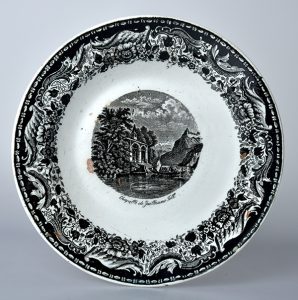
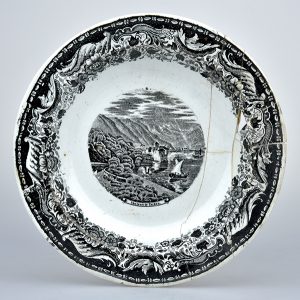
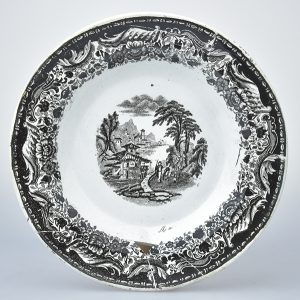
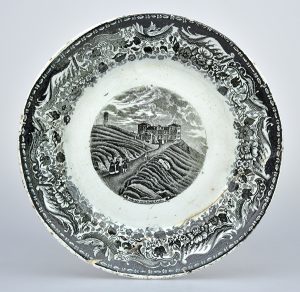
Pottery from Kilchberg-Schooren in CERAMICA CH
Roland Blaettler und Andreas Heege 2019
No less than four faience manufactories were in operation on the western shore of Lake Zurich in the 19th century. In Kilchberg it was the Nägeli factory (in operation in the Schooren area between 1802 and 1857) and the Scheller factory (in operation between 1820 and 1869, first in the Böndler area, and from 1835 onwards in the Schooren area); in the neighbouring town of Rüschlikon it was the Jakob Fehr manufactory from 1832 to 1866 and the Abegg brothers’ manufactory from 1836 to 1842. The products made by these companies were all very similar in shape and decoration, which means that, given the current state of knowledge, we are not yet able to make a clear distinction between them.
Kilchberg-Schooren, Manufaktur Johannes Scheller
Kilchberg-Schooren, Johannes Scheller manufactory
In 1820, Johannes Scheller (1775-1846) founded a second faience manufactory (next to that of Hans Jakob Nägeli) in the “Böndler” area of Kilchberg (now 203 Alte Landstrasse). In 1835, he moved it to 201 Seestrasse in Schooren. When the company founder died in 1846, Johannes Scheller jun. (1815-1869) took over the running of the manufactory (Frei 1930) and began to produce refined white earthenware with transfer-printed decoration (some bearing Swiss motifs, e.g. RMC H1972.731; RMC H1972.732; RMC H1971.733; RMC H1971.1088). He successfully managed the factory until the 1860s. In 1857, it had a staff of 125 workers; by around 1860, this number is believed to have increased to 200. The factory ceased operation in 1869 when the company went bankrupt (Matter 2012, 17, 114-115).
However, Martin (?) Bodmer zur Arch from Zurich continued to produce (or perhaps just sell?) the wares, though the size of the output is not known. In 1873, business associates Fehr and Höhn from Kilchberg acquired the company and continued production until 1874, when it finally ceased trading (Ducret 1951, 180).
Copies of two pattern books from the Scheller manufactory have survived, and in 2007, they were published for the first time by Peter Ducret (Ducret 2007). At least one of them can be dated to the period prior to 1859 according to the inscription on its cover. The pattern books give an overview not only of the contemporaneous vessel shapes but also tell us what certain shapes and decorations were called at the time. The undated list gives the object names in German and French, whereas the second list is in German only. Comparing a roughly contemporaneous pattern book from Schramberg (Heege 2013), the close similarity between the Scheller and Schramberg products is immediately obvious.
Scheller, Kilchberg-Schooren pattern books
Faience from Kilchberg and Rüschlikon
It is still quite difficult to distinguish between the products from the four manufactories on Lake Zurich, particularly with regard to the basic shapes, which were rather simple and almost identical. The more complex shapes of the tureens, on the other hand, have formal details that allow us to attribute them to the individual factories. Rudolf Schnyder’s definitions for the typical shapes from the two main manufactories, Nägeli (HMO 8689; AF No. 28) and Scheller, (AF No. 25; AF No. 73; HMO 8149), are very convincing (Schnyder 1990).
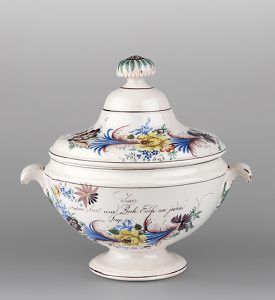

Nägeli
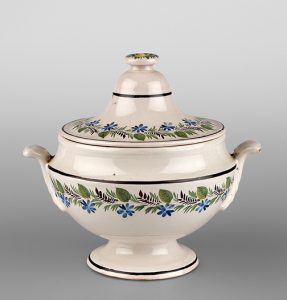
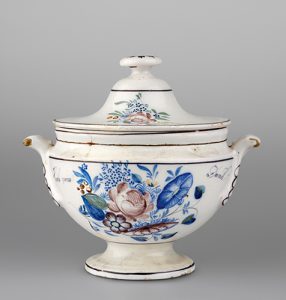
Scheller
While this preliminary distinction using formal criteria allows us to compare the decorations on the products of the two rival companies, we cannot be entirely certain about which company produced each individual type. The difficulty arises because we know that the painters moved from one company to the other, and Schnyder also pointed out that some shapes could even have been made by Fehr or Abegg in Rüschlikon, though their products are more rarely found, and attributions are still largely hypothetical (KMM 225; MBS 1944.93; HMO 8141; SFM 113; SFM 111; SFM 112; AF Nr. 74).
We have refrained from offering comparisons and in-depth studies on the faience products from Kilchberg and Rüschlikon. The only vessels that we have attributed to a particular producer are the ones where it seems obvious which factory they originated from, but we have also added the Rüschlikon makers proposed by Rudolf Schnyder. The label “Kilchberg” has been used for pieces that were made either by Nägeli in the Schooren area or by Scheller in the Böndler area before he also moved his company to the Schooren area in 1835. The label “Kilchberg-Schooren”, on the other hand, has been used for objects made by Nägeli or by Scheller after 1835. It is indeed possible that some of the faience pieces that we have attributed to “Kilchberg” or to “Kilchberg-Schooren” will turn out to have been made in Rüschlikon at some time in the future.
Translation Sandy Haemmerle
References:
Blaettler/Schnyder 2014
Roland Blaettler/Rudolf Schnyder, CERAMICA CH II: Solothurn (Nationales Inventar der Keramik in den öffentlichen Sammlungen der Schweiz (1500–1950), Sulgen 2014, 42–43
Ducret 1951
Siegfried Ducret, Schoorensteingut des 19. Jh. Zeitschrift für Schweizerische Archäologie und Kunstgeschichte 12, 1951, 175–180.
Ducret 2007
Peter Ducret, Bedrucktes Steingut aus der Manufaktur Scheller in Kilchberg, in: Keramik-Freunde der Schweiz, Mitteilungsblatt Nr. 119/120, 2007.
Frei 1930
Karl Frei, Lebenserinnerungen des Fayencefabrikanten Johannes Scheller von Kilchberg, in: Zürcher Taschenbuch 50, 1930, 157-210.
Heege 2013
Andreas Heege, Ein unbekanntes Musterbuch der ersten königlich württembergischen Steingutmanufaktur Schramberg (Uechtritz&Faist) aus der Zeit nach 1855 in: Harald Siebenmorgen, Blick nach Westen. Keramik in Baden und im Elsass. 45. Internationales Symposium Keramikforschung Badisches Landesmuseum Karlsruhe 24.8.-28.9.2012, Karlsruhe 2013, 107-115.
Matter 2012
Annamaria Matter, Die archäologische Untersuchung in der ehemaligen Porzellanmanufaktur Kilchberg-Schooren. Keramikproduktion am linken Zürichseeufer 1763–1906 (Monographien der Kantonsarchäologie Zürich 43), Zürich 2012.
Schnyder 1990
Rudolf Schnyder, Schweizer Biedermeier-Fayencen, Schooren und Matzendorf. Sammlung Gubi Leemann, Bern 1990.

